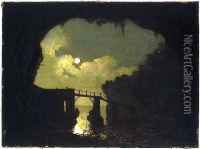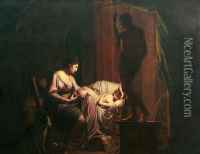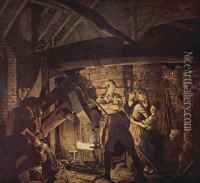Joseph Wright Paintings
Joseph Wright, commonly known as Joseph Wright of Derby, was an English landscape and portrait painter who has been acclaimed for his use of chiaroscuro and for his paintings which feature scientific and industrial subjects. Born on September 3, 1734, in Derby, England, Wright was the first major English painter to be trained outside of London, which helped him develop a distinctive style.
Wright's early career included a period of study with the portrait painter Thomas Hudson in London before returning to Derby where he found a niche painting portraits for the local gentry and middle class. His works during this time were notable for their skillful use of lighting and focus on the realism of the subjects.
However, it was his later works that truly distinguished him. Wright is particularly remembered for his paintings that depict scenes from the Industrial Revolution, which was beginning to take hold in Britain at the time. His famous painting 'An Experiment on a Bird in the Air Pump' (1768) exemplifies his interest in scientific subjects and his remarkable ability to capture the drama of the moment.
Another significant contribution by Wright was his series of paintings known as the 'Candlelight Pictures', which included 'The Alchemist Discovering Phosphorus' (1771) and 'A Philosopher Giving a Lecture on the Orrery' (1766). These works are renowned for their use of light to create a dramatic atmosphere, illustrating his fascination with the contrast between light and shadow and the impact of scientific discovery.
Wright's art was also influenced by his two trips to Italy, from 1773 to 1775, and again in 1775 to 1776, where he was deeply impressed by the works of the Old Masters and the dramatic Italian landscapes, which he incorporated into his own style.
Joseph Wright of Derby's legacy includes being a prominent figure in the Midlands Enlightenment and a member of the Lunar Society, a group of thinkers and inventors who met regularly in the Midlands. He passed away on August 29, 1797, in Derby. Wright is remembered not only for his unique and dramatic portrayal of industrial and scientific advancements but also for his contribution to the development of the English school of painting.

















